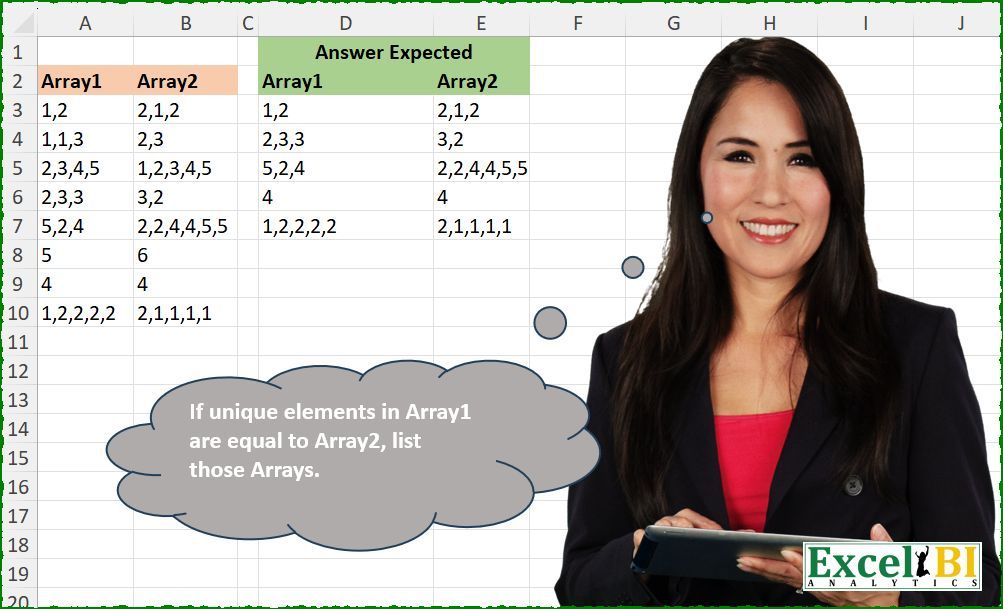library(tidyverse)
library(readxl)
path = "Excel/634 Array Equality.xlsx"
input = read_excel(path, range = "A2:B10")
test = read_excel(path, range = "D2:E7")
result = input %>%
mutate(
set_array1 = map(Array1, ~ sort(unique(strsplit(.x, ",")[[1]]))), # Split, deduplicate, and sort Array1
set_array2 = map(Array2, ~ sort(unique(strsplit(.x, ",")[[1]]))) # Split, deduplicate, and sort Array2
) %>%
mutate(result = map2(set_array1, set_array2, ~ .x %>% setequal(.y))) # Compare the processed arrays
filter(result == TRUE) %>% # Filter rows where arrays are equal
select(Array1, Array2) # Keep only Array1 and Array2 columns
all.equal(result, test, check.attributes = FALSE)
#> [1] TRUEExcel BI - Excel Challenge 634

Challenge Description
🔰Group every five rows of the question table and then provide some of quantity for each group
🔗 Link to Excel file: 👉https://lnkd.in/dHgBqfH4
Solutions
Logic:
strsplit: Splits array strings into individual elements using,as the delimiter.uniqueandsort: Deduplicates and sorts elements for consistency.setequal: Checks if the two arrays contain the same elements, regardless of order.filter: Keeps rows where arrays are equal.
Strengths:
Clean Transformation: Uses tidyverse functions for concise and readable code.
Flexibility: Handles arrays of varying lengths and ensures order doesn’t affect the comparison.
Areas for Improvement:
- Performance: Processing could be optimized for very large datasets with many rows.
Gem:
- The use of
setequalensures robust and order-independent equality checks.
- The use of
import pandas as pd
path = "634 Array Equality.xlsx"
input = pd.read_excel(path, usecols="A:B", skiprows=1, nrows=9)
test = pd.read_excel(path, usecols="D:E", skiprows=1, nrows=5).rename(columns=lambda x: x.split('.')[0])
def split_sort_unique(s):
return sorted(set(s.split(','))) # Split, deduplicate, and sort
input['set_array1'] = input['Array1'].apply(split_sort_unique) # Process Array1
input['set_array2'] = input['Array2'].apply(split_sort_unique) # Process Array2
input['result'] = input.apply(lambda row: row['set_array1'] == row['set_array2'], axis=1) # Compare arrays
result = input[input['result'] == True][['Array1', 'Array2']].reset_index(drop=True) # Filter and reset index
print(result)
print(test)Logic:
split_sort_unique: Splits array strings into individual elements, removes duplicates, and sorts.apply: Applies the processing function to both arrays.Row-wise comparison: Checks if the processed arrays are equal.
Filtering: Keeps rows where arrays are equal.
Strengths:
Explicit Logic: Each step is modular and easy to understand.
Flexibility: Handles variations in input data robustly.
Areas for Improvement:
- Performance: Row-wise operations (
apply) may be slower for very large datasets; vectorization could improve speed.
- Performance: Row-wise operations (
Gem:
- The use of
sorted(set(...))effectively ensures that order and duplicates don’t affect the comparison.
- The use of
Difficulty Level
This task is moderate:
Requires knowledge of string processing, deduplication, and order-independent comparison.
Involves working with potentially variable-length arrays.